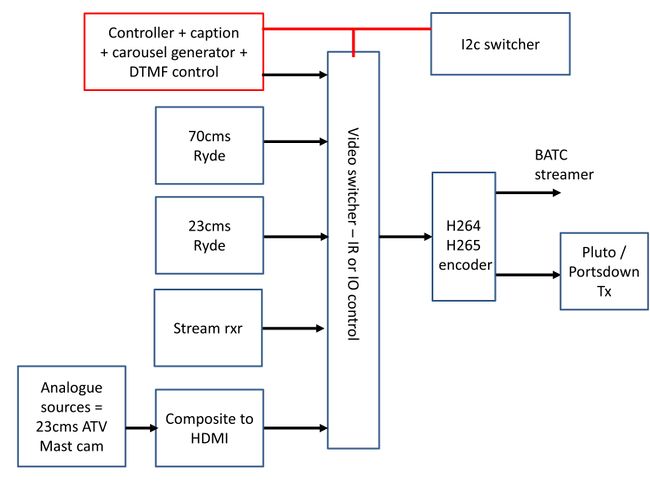Difference between revisions of "Repeater Controller"
| Line 37: | Line 37: | ||
While this software is designed to work "out of the box" it will need to be configured for each individual repeater (with callsign at the very least). | While this software is designed to work "out of the box" it will need to be configured for each individual repeater (with callsign at the very least). | ||
| + | |||
| + | Most configuration can be done using the SSH menu - for more details see the Repeater Controller configuration page. | ||
Most customisation will require the careful editing of the text file /home/pi/atv-rptr/config/repeater_config.txt; following this, the repeater will need to be rebooted to load the new settings (although you can just type "restart" at the ssh command prompt for testing). Some real-time control is possible using the ssh Console Menu (type menu at the ssh command prompt), but the configuration file is too comprehensive for all the functions to be edited from a simple menu. | Most customisation will require the careful editing of the text file /home/pi/atv-rptr/config/repeater_config.txt; following this, the repeater will need to be rebooted to load the new settings (although you can just type "restart" at the ssh command prompt for testing). Some real-time control is possible using the ssh Console Menu (type menu at the ssh command prompt), but the configuration file is too comprehensive for all the functions to be edited from a simple menu. | ||
Revision as of 17:28, 13 February 2022
The BATC ATV Repeater Controller uses a Raspberry Pi 4 as a fully-featured, but simple-to-construct, ATV repeater controller. The design is intended to be used with an HDMI Video switch, but can also be used with older composite video designs.
Every repeater is different and this is designed as a core logic that can be used as the basis for an ATV repeater. The design is flexible with a large number of parameters in an SSH config file so that users can configure it to meet their own needs.
Initial design and construction information will be published here to enable collaborative development, but will be subject to change as the project develops.
The outline requirement specification is here media:BATC ATV repeater controller.pdf
Typical operation
The BATC repeater controller will control either a single or multiple video switchers either by InfraRed or GPIO pins and will generate a carousel of scenes.
The carousel can be configured to show up to 99 scenes which can be .jpg or .png images, an input on the video switcher for example mast cam, or a video file. The still images are read each time before display so can be regularly updated by an external source.
On receipt of a valid signal from, for example, a Ryde receiver, the controller will, key the transmitter, play an image for .5 seconds indicating which input has been activated and then switch to that input. When the receiver closes, the logic will play a Kimage and optional K in Morse, dekey the tx and go back to the carousel.
The receiver input switching line can be directly from a Ryde receiver or an external source such as a sync detector on an analogue source. Note do NOT exceed 3.3 volts on the GPIO input.
A video and/or audio ident can be generated at an interval set in the config file.
An on-board DTMF generator will allow input selection by remote control and also enable GPIO pins to be toggled to enable the control of external equipment.
Switcher configurations
The basic design uses one or 2 IR transmitters to control one or 2 HDMI switches.
Configuring IR Switching
The IR codes for the HDMI switches used on your repeater will need to entered in the configuration file.
Full details are here: Configuring IR for HDMI Switching
Customisation
While this software is designed to work "out of the box" it will need to be configured for each individual repeater (with callsign at the very least).
Most configuration can be done using the SSH menu - for more details see the Repeater Controller configuration page.
Most customisation will require the careful editing of the text file /home/pi/atv-rptr/config/repeater_config.txt; following this, the repeater will need to be rebooted to load the new settings (although you can just type "restart" at the ssh command prompt for testing). Some real-time control is possible using the ssh Console Menu (type menu at the ssh command prompt), but the configuration file is too comprehensive for all the functions to be edited from a simple menu.
Project status
The target release date is the end of March 2022.
An early version of the software (not yet ready for use, but good enought for shack-based testing) can be found here: https://github.com/BritishAmateurTelevisionClub/atv-rptr
Switching Logic
A detailed description of the operation of the switching logic can be found here: Repeater Switching Logic.
GPIO Connections
The repeater controller will switch a GPIO output to indicate one of up to eight receiver inputs has been activated.
This can be used to control an external video switcher but note care MUST be taken to buffer the 3.3 volt logic levels used on the Raspberry Pi GPIO pins.
An initial list of GPIO connections is here: Repeater GPIO Connections.
